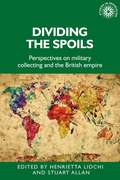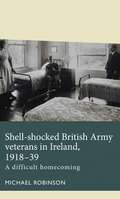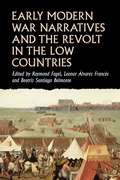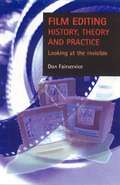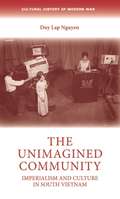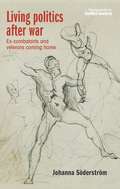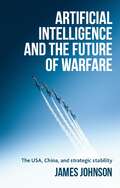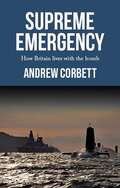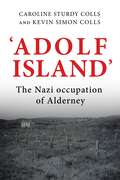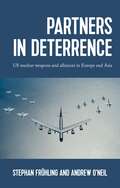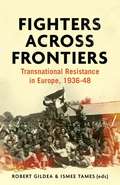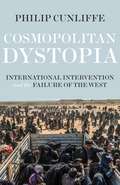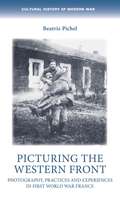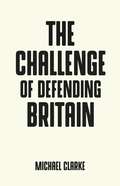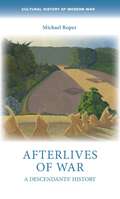- Table View
- List View
Dividing the spoils: Perspectives on military collections and the British empire (Studies in Imperialism)
by Alan LesterAt a time of heightened international interest in the colonial dimensions of museum collections, Dividing the Spoils provides new perspectives on the motivations and circumstances whereby collections were appropriated and acquired during colonial military service. Combining approaches from the fields of material anthropology, imperial and military history, this book argues for a deeper examination of these collections within a range of intercultural histories that include alliance, diplomacy, curiosity and enquiry, as well as expropriation and cultural hegemony. As museums across Europe reckon with the post-colonial legacies of their collections, Dividing the Spoils explores how the amassing of objects was understood and governed in British military culture, and considers how objects functioned in museum collections thereafter, suggesting new avenues for sustained investigation in a controversial, contested field.
Dividing the spoils: Perspectives on military collections and the British empire (Studies in Imperialism)
by Alan LesterAt a time of heightened international interest in the colonial dimensions of museum collections, Dividing the Spoils provides new perspectives on the motivations and circumstances whereby collections were appropriated and acquired during colonial military service. Combining approaches from the fields of material anthropology, imperial and military history, this book argues for a deeper examination of these collections within a range of intercultural histories that include alliance, diplomacy, curiosity and enquiry, as well as expropriation and cultural hegemony. As museums across Europe reckon with the post-colonial legacies of their collections, Dividing the Spoils explores how the amassing of objects was understood and governed in British military culture, and considers how objects functioned in museum collections thereafter, suggesting new avenues for sustained investigation in a controversial, contested field.
Shell-shocked British Army veterans in Ireland, 1918-39: A difficult homecoming (Disability History)
by Michael RobinsonWith a focus on mental illness, Shell-shocked British Army veterans in Ireland provides the first in-depth investigation of disabled Great War veterans in Ireland. The book is a result of five years of researching previously untouched archival sources including psychiatric records of former patients otherwise closed to the public. The remit of the work contributes to various historiographical fields including disability history, the social history of medicine, the cultural history of modern war, the history of psychiatry and Irish studies. It also seeks to extend the scope of the First World War with an emphasis on how war-induced disability and trauma continued to affect large numbers of ex-servicemen beyond the official cessation of the conflict.
Shell-shocked British Army veterans in Ireland, 1918-39: A difficult homecoming (Disability History)
by Michael RobinsonWith a focus on mental illness, Shell-shocked British Army veterans in Ireland provides the first in-depth investigation of disabled Great War veterans in Ireland. The book is a result of five years of researching previously untouched archival sources including psychiatric records of former patients otherwise closed to the public. The remit of the work contributes to various historiographical fields including disability history, the social history of medicine, the cultural history of modern war, the history of psychiatry and Irish studies. It also seeks to extend the scope of the First World War with an emphasis on how war-induced disability and trauma continued to affect large numbers of ex-servicemen beyond the official cessation of the conflict.
Early modern war narratives and the Revolt in the Low Countries (Studies in Early Modern European History)
by Raymond Fagel Leonor Álvarez Francés Beatriz Santiago BelmonteBy the end of the sixteenth century, stories about the Revolt in the Low Countries (c. 1567–1648) had begun to spread throughout Europe. These stories had very different authors with very different intentions. Over time the plethora of sources and interpretations faded away, leaving us with opposing canonical narratives. The Dutch and Spanish national myths were forged on the basis of two visions of the conflict: as a liberation war against cruel Spanish oppressors and as a glorious episode in the history of the Spanish Empire. This volume delves into the early, seemingly anecdotal stories of the war to map the great variety and interconnection of the narratives. It asks such questions as how did the Jesuits write about the Revolt, what can we find in Italian chronicles and how did the war look from the perspective of a local nobleman or a Spanish commander?
Early modern war narratives and the Revolt in the Low Countries (Studies in Early Modern European History)
by William G. Naphy Raymond Fagel Leonor Álvarez Francés Beatriz Santiago BelmonteBy the end of the sixteenth century, stories about the Revolt in the Low Countries (c. 1567–1648) had begun to spread throughout Europe. These stories had very different authors with very different intentions. Over time the plethora of sources and interpretations faded away, leaving us with opposing canonical narratives. The Dutch and Spanish national myths were forged on the basis of two visions of the conflict: as a liberation war against cruel Spanish oppressors and as a glorious episode in the history of the Spanish Empire. This volume delves into the early, seemingly anecdotal stories of the war to map the great variety and interconnection of the narratives. It asks such questions as how did the Jesuits write about the Revolt, what can we find in Italian chronicles and how did the war look from the perspective of a local nobleman or a Spanish commander?
Film editing - history, theory and practice: Looking at the invisible
by Don FairserviceThe first-ever comprehensive examination of the film editor's craft from the beginning of cinema to the present day. Of all the film-making crafts, editing is the least understood. Using examples drawn from classic film texts, this book clarifies the editor's role and explains how the editing process maximises the effectiveness of the filmed material. Traces the development of editing from the primitive forms of early cinema through the upheavals caused by the advent of sound, to explore the challenges to convention that began in the 1960s and which continue into the twenty-first century. New digital technologies and the dominance of the moving image as an increasingly central part of everyday life have produced a radical rewriting of the rules of audio-visual address. It is not a technical treatise; instructive and accessible, this historically-based insight into filmmaking practice will prove invaluable to students of film and also appeal to a much wider readership.
The unimagined community: Imperialism and culture in South Vietnam (Cultural History of Modern War)
by Duy Lap NguyenThe unimagined community proposes a reexamination of the Vietnam War from a perspective that has been largely excluded from historical accounts of the conflict, that of the South Vietnamese. Challenging the conventional view that the war was a struggle between the Vietnamese people and US imperialism, the study presents a wide-ranging investigation of South Vietnamese culture, from political philosophy and psychological warfare to popular culture and film. Beginning with a genealogy of the concept of a Vietnamese “culture,” as the latter emerged during the colonial period, the book concludes with a reflection on the rise of popular culture during the American intervention. Reexamining the war from the South Vietnamese perspective, The unimagined community pursues the provocative thesis that the conflict, in this early stage, was not an anti-communist crusade, but a struggle between two competing versions of anticolonial communism.
The unimagined community: Imperialism and culture in South Vietnam (Cultural History of Modern War)
by Duy Lap NguyenThe unimagined community proposes a reexamination of the Vietnam War from a perspective that has been largely excluded from historical accounts of the conflict, that of the South Vietnamese. Challenging the conventional view that the war was a struggle between the Vietnamese people and US imperialism, the study presents a wide-ranging investigation of South Vietnamese culture, from political philosophy and psychological warfare to popular culture and film. Beginning with a genealogy of the concept of a Vietnamese “culture,” as the latter emerged during the colonial period, the book concludes with a reflection on the rise of popular culture during the American intervention. Reexamining the war from the South Vietnamese perspective, The unimagined community pursues the provocative thesis that the conflict, in this early stage, was not an anti-communist crusade, but a struggle between two competing versions of anticolonial communism.
Living politics after war: Ex-combatants and veterans coming home (New Approaches to Conflict Analysis)
by Johanna SöderströmLife after war is intrinsically political for former combatants. As wars end, societies and former combatants face a period of transition. This book explores the experience of coming home for former combatants, capturing the challenges and opportunities for political mobilization among former combatants as they return from three very different wars: South West Africa People’s Organization combatants who participated in the Namibian War of Independence (1966–90); guerrillas from Movimiento 19 de Abril who joined the ongoing guerilla warfare conducted against the Colombian state (1974–90), and combatants from the United States who participated in the Vietnam War (1955–75). Offering an insightful perspective on peace as a process through the long-term study of the lives of fifty former combatants, Söderström demonstrates how the process of coming home shapes their political commitment and identity. Combining detailed scholarship with interviews with former combatants, this volume serves as a powerful reminder of the legacies of war in the lives of former combatants.
Living politics after war: Ex-combatants and veterans coming home (New Approaches to Conflict Analysis)
by Johanna SöderströmLife after war is intrinsically political for former combatants. As wars end, societies and former combatants face a period of transition. This book explores the experience of coming home for former combatants, capturing the challenges and opportunities for political mobilization among former combatants as they return from three very different wars: South West Africa People’s Organization combatants who participated in the Namibian War of Independence (1966–90); guerrillas from Movimiento 19 de Abril who joined the ongoing guerilla warfare conducted against the Colombian state (1974–90), and combatants from the United States who participated in the Vietnam War (1955–75). Offering an insightful perspective on peace as a process through the long-term study of the lives of fifty former combatants, Söderström demonstrates how the process of coming home shapes their political commitment and identity. Combining detailed scholarship with interviews with former combatants, this volume serves as a powerful reminder of the legacies of war in the lives of former combatants.
Artificial intelligence and the future of warfare: The USA, China, and strategic stability
by James JohnsonThis volume offers an innovative and counter-intuitive study of how and why artificial intelligence-infused weapon systems will affect the strategic stability between nuclear-armed states. Johnson demystifies the hype surrounding artificial intelligence (AI) in the context of nuclear weapons and, more broadly, future warfare. The book highlights the potential, multifaceted intersections of this and other disruptive technology – robotics and autonomy, cyber, drone swarming, big data analytics, and quantum communications – with nuclear stability. Anticipating and preparing for the consequences of the AI-empowered weapon systems are fast becoming a critical task for national security and statecraft. Johnson considers the impact of these trends on deterrence, military escalation, and strategic stability between nuclear-armed states – especially China and the United States. The book draws on a wealth of political and cognitive science, strategic studies, and technical analysis to shed light on the coalescence of developments in AI and other disruptive emerging technologies. Artificial intelligence and the future of warfare sketches a clear picture of the potential impact of AI on the digitized battlefield and broadens our understanding of critical questions for international affairs. AI will profoundly change how wars are fought, and how decision-makers think about nuclear deterrence, escalation management, and strategic stability – but not for the reasons you might think.
Artificial intelligence and the future of warfare: The USA, China, and strategic stability
by James JohnsonThis volume offers an innovative and counter-intuitive study of how and why artificial intelligence-infused weapon systems will affect the strategic stability between nuclear-armed states. Johnson demystifies the hype surrounding artificial intelligence (AI) in the context of nuclear weapons and, more broadly, future warfare. The book highlights the potential, multifaceted intersections of this and other disruptive technology – robotics and autonomy, cyber, drone swarming, big data analytics, and quantum communications – with nuclear stability. Anticipating and preparing for the consequences of the AI-empowered weapon systems are fast becoming a critical task for national security and statecraft. Johnson considers the impact of these trends on deterrence, military escalation, and strategic stability between nuclear-armed states – especially China and the United States. The book draws on a wealth of political and cognitive science, strategic studies, and technical analysis to shed light on the coalescence of developments in AI and other disruptive emerging technologies. Artificial intelligence and the future of warfare sketches a clear picture of the potential impact of AI on the digitized battlefield and broadens our understanding of critical questions for international affairs. AI will profoundly change how wars are fought, and how decision-makers think about nuclear deterrence, escalation management, and strategic stability – but not for the reasons you might think.
Supreme emergency: How Britain lives with the Bomb
by Andrew CorbettIn Supreme emergency, an ex-Trident submarine captain considers the evolution of UK nuclear deterrence policy and the implications of a previously unacknowledged aversion to military strategies that threaten civilian casualties. Drawing on extensive archival research, the book provides a unique synthesis of the factors affecting British nuclear policy decision-making and draws parallels between government debates about reprisals for First World War zeppelin raids on London, the strategic bombing raids of the Second World War and the evolution of the UK nuclear deterrent. It concludes that among all the technical factors, an aversion to being seen to condone civilian casualties has inhibited government engagement with the public on deterrence strategy since 1915.
'Adolf Island': The Nazi occupation of Alderney
by Caroline Sturdy Colls Kevin Colls‘Adolf Island’ offers new forensic, archaeological and spatial perspectives on the Nazi forced and slave labour programme that was initiated on the Channel Island of Alderney during its occupation in the Second World War. Drawing on extensive archival research and the results of the first in-field investigations of the ‘crime scenes’ since 1945, the book identifies and characterises the network of concentration and labour camps, fortifications, burial sites and other material traces connected to the occupation, providing new insights into the identities and experiences of the men and women who lived, worked and died within this landscape. Moving beyond previous studies focused on military aspects of occupation, the book argues that Alderney was intrinsically linked to wider systems of Nazi forced and slave labour.
'Adolf Island': The Nazi occupation of Alderney
by Caroline Sturdy Colls Kevin Colls‘Adolf Island’ offers new forensic, archaeological and spatial perspectives on the Nazi forced and slave labour programme that was initiated on the Channel Island of Alderney during its occupation in the Second World War. Drawing on extensive archival research and the results of the first in-field investigations of the ‘crime scenes’ since 1945, the book identifies and characterises the network of concentration and labour camps, fortifications, burial sites and other material traces connected to the occupation, providing new insights into the identities and experiences of the men and women who lived, worked and died within this landscape. Moving beyond previous studies focused on military aspects of occupation, the book argues that Alderney was intrinsically linked to wider systems of Nazi forced and slave labour.
Partners in deterrence: US nuclear weapons and alliances in Europe and Asia
by Stephan Frühling Andrew O'NeilFrom the dawn of the atomic age to today, nuclear weapons have been central to the internal dynamics of US alliances in Europe and Asia. But nuclear weapons cooperation in US alliances has varied significantly between allies and over time. Partners in deterrence explores the history of America’s nuclear posture worldwide, delving into alliance structures and interaction during and since the end of the Cold War to uncover the underlying dynamics of nuclear weapons cooperation between the US and its allies. Combining in-depth empirical analysis with an accessible theoretical lens, the book reveals that US allies have wielded significant influence in shaping nuclear weapons cooperation with the US in ways that reflect their own, often idiosyncratic, objectives. Alliances are ecosystems of exchange rather than mere tools of external balancing, Frühling and O’Neil argue, and institutional perspectives can offer an unprecedented insight into how structured cooperation can promote policy convergence.
Fighters across frontiers: Transnational resistance in Europe, 1936–48
by Robert Gildea and Ismee TamesThis landmark book, the product of years of research by a team of two dozen historians, reveals that resistance to occupation by Nazi Germany and Fascist Italy during the Second World War was not narrowly delineated by country but startlingly international. Tens of thousands of fighters across Europe resisted ‘transnationally’, travelling to join networks far from their homes. These ‘foreigners’ were often communists and Jews who were already being persecuted and on the move. Others were expatriate business people, escaped POWs, forced labourers or deserters. Their experiences would prove personally transformative and greatly affected the course of the conflict. From the International Brigades in Spain to the onset of the Cold War and the foundation of the state of Israel, they played a significant part in a period of upheaval and change during the long Second World War.
Fighters across frontiers: Transnational resistance in Europe, 1936–48
by Robert Gildea Ismee TamesThis landmark book, the product of years of research by a team of two dozen historians, reveals that resistance to occupation by Nazi Germany and Fascist Italy during the Second World War was not narrowly delineated by country but startlingly international. Tens of thousands of fighters across Europe resisted ‘transnationally’, travelling to join networks far from their homes. These ‘foreigners’ were often communists and Jews who were already being persecuted and on the move. Others were expatriate business people, escaped POWs, forced labourers or deserters. Their experiences would prove personally transformative and greatly affected the course of the conflict. From the International Brigades in Spain to the onset of the Cold War and the foundation of the state of Israel, they played a significant part in a period of upheaval and change during the long Second World War.
Cosmopolitan dystopia: International intervention and the failure of the West (Manchester University Press)
by Philip CunliffeCosmopolitan Dystopia shows that rather than populists or authoritarian great powers it is cosmopolitan liberals who have done the most to subvert the liberal international order. Cosmopolitan Dystopia explains how liberal cosmopolitanism has led us to treat new humanitarian crises as unprecedented demands for military action, thereby trapping us in a loop of endless war. Attempts to normalize humanitarian emergency through the doctrine of the ‘responsibility to protect’ has made for a paternalist understanding of state power that undercuts the representative functions of state sovereignty. The legacy of liberal intervention is a cosmopolitan dystopia of permanent war, insurrection by cosmopolitan jihadis and a new authoritarian vision of sovereignty in which states are responsible for their peoples rather than responsible to them. This book will be of vital interest to scholars and students of international relations, IR theory and human rights.
Picturing the Western Front: Photography, practices and experiences in First World War France (Cultural History of Modern War)
by Dr Beatriz PichelBetween 1914 and 1918, military, press and amateur photographers produced thousands of pictures. Either classified in military archives specially created with this purpose in 1915, collected in personal albums or circulated in illustrated magazines, photographs were supposed to tell the story of the war. Picturing the Western Front argues that photographic practices also shaped combatants and civilians’ war experiences. Doing photography (taking pictures, posing for them, exhibiting, cataloguing and looking at them) allowed combatants and civilians to make sense of what they were living through. Photography mattered because it enabled combatants and civilians to record events, establish or reinforce bonds with one another, represent bodies, place people and events in imaginative geographies and making things visible, while making others, such as suicide, invisible. Photographic practices became, thus, frames of experience.
Picturing the Western Front: Photography, practices and experiences in First World War France (Cultural History of Modern War)
by Dr Beatriz PichelBetween 1914 and 1918, military, press and amateur photographers produced thousands of pictures. Either classified in military archives specially created with this purpose in 1915, collected in personal albums or circulated in illustrated magazines, photographs were supposed to tell the story of the war. Picturing the Western Front argues that photographic practices also shaped combatants and civilians’ war experiences. Doing photography (taking pictures, posing for them, exhibiting, cataloguing and looking at them) allowed combatants and civilians to make sense of what they were living through. Photography mattered because it enabled combatants and civilians to record events, establish or reinforce bonds with one another, represent bodies, place people and events in imaginative geographies and making things visible, while making others, such as suicide, invisible. Photographic practices became, thus, frames of experience.
The challenge of defending Britain (Pocket Politics)
by Michael ClarkeAn analysis that takes the complexity of British defence policy apart to view its anatomy and show how policy is made in this area. British defence policy is in a phase of great transition as the country confronts its Brexit future and also as world politics becomes more threatening and potentially unstable. This book uses the most up to date information to examine in a concise and readable way all the elements that go to make up Britain’s defence policy as it goes through the most significant transition since the end of the Cold War in 1991. By analysing the costs of defence, the equipment issues, the personnel, the technical and intelligence back-up for it, and the strategies to employ military forces, this book offers a brief but rich guide to understanding an area of policy that many people find baffling.
Afterlives of war: A descendants' history (Cultural History of Modern War)
by Michael RoperAfterlives of war documents the lives and historical pursuits of the generations who grew up in Australia, Britain and Germany after the First World War. Although they were not direct witnesses to the conflict, they experienced its effects from their earliest years. Based on ninety oral history interviews and observation during the First World War Centenary, this pioneering study reveals the contribution of descendants to the contemporary memory of the First World War, and the intimate personal legacies of the conflict that animate their history-making.
Afterlives of war: A descendants' history (Cultural History of Modern War)
by Michael RoperAfterlives of war documents the lives and historical pursuits of the generations who grew up in Australia, Britain and Germany after the First World War. Although they were not direct witnesses to the conflict, they experienced its effects from their earliest years. Based on ninety oral history interviews and observation during the First World War Centenary, this pioneering study reveals the contribution of descendants to the contemporary memory of the First World War, and the intimate personal legacies of the conflict that animate their history-making.
